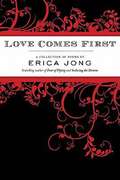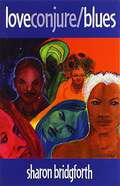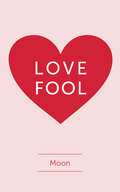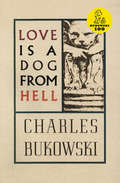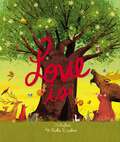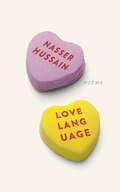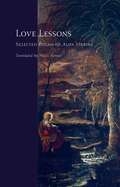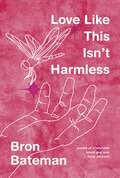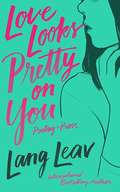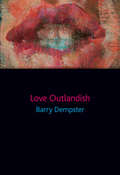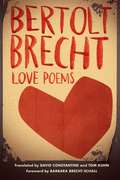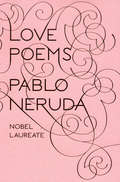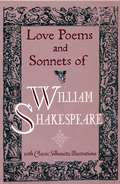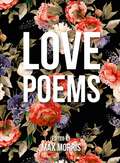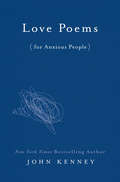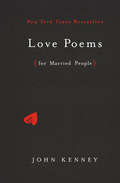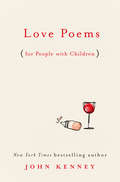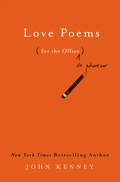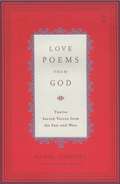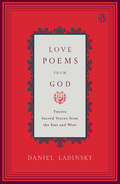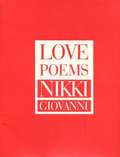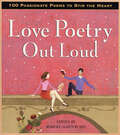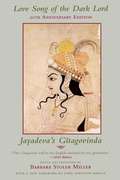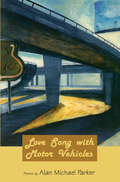- Table View
- List View
Love Comes First
by Erica JongLove Comes First is Erica Jong's long-awaited return to her poetic roots! Here is Erica Jong's first book of all-new poems in more than a decade. Known and beloved for Fear of Flying and her many other books of fiction, nonfiction and poetry, Jong expounds on the most eternal, universal topic of all: love. Using brilliant imagery and intense metaphorical insights to paint vivid pictures of love, and all that comes with it--the heights of elation, the depths of sorrow--she covers every inch of the spectrum with her vibrant and insightful words. Perfect for wedding showers, lovers of all ages, and Valentine's Day, Jong's trademark trailblazing style and remarkable ability to bridge the gap between literary and popular poetry makes Love Comes First an instant classic. Discover-- or discover yet again--the brilliance of Erica Jong. Watch the trailer for this book:
Love Conjure/Blues
by Sharon BridgforthLOVE CONJURE/BLUES is performance literature/a novel that is constructed for breath. The piece is not meant to be theater/a concert/an opera or a staged reading but is. <p><p>LOVE CONJURE/BLUES places the fiction- form inside a traditional Black American voice/inviting dramatic interpretation and movement within the fit of a highly literary text—filled with folktales poetry haints prophecy song and oral history. <p><p>LOVE CONJURE/BLUES considers a range of possibilities of gender expression and sexuality within a southern/rural/Black working class context that examines the blues as a way of life/as ritual—in concert with Ancient practices and new creations. The past the present the future the living and the dead co-exist together/at the same time in a weave of dreams/Prayers/Love/Spirit expressed.
Love Fool
by Moon‘They said never love a fool ’coz your eyes shine in a fool but when love knocks on you grab love like a fool ’coz you are indeed a love fool They said never be a fool ’coz love runs from a fool but when love stands in your eyes you can’t hide a fool ’coz you are the fool’ We live life only once, let’s love freely as far as destiny takes us.
Love Is a Dog from Hell
by Charles BukowskiFirst published in 1977, Love Is a Dog from Hell is a collection of Bukowski's poetry from the mid-seventies. A classic in the Bukowski canon, Love Is a Dog from Hell is a raw, lyrical, exploration of the exigencies, heartbreaks, and limits of love.
Love Is: An Illustrated Exploration of God’s Greatest Gift (Based on 1 Corinthians 13:4-8)
by Zondervan&“Love is patient, love is kind.&” These familiar words from the Bible begin one of its most beloved and recognized passages. Love Is brings the text of 1 Corinthians 13 to life through an illustrative exploration of God&’s greatest gift to us.Critically acclaimed artist Paola Escobar delivers beautiful, nature-filled illustrations , reminding us that love is a constant positive force in the lives of those touched by it–from beginning to end, through good times and tough times.This beautiful, jacketed hardcover:Will appeal to parents and grandparents of children ages 4-8Draws directly from the New International Reader&’s Version of the Holy BibleFeatures stunning illustrations by award-winning artist Paola EscobarIs perfect for gift-giving for Christmas, Valentine&’s Day and birthdaysIs especially giftable for anniversaries, engagements or weddingsLove Is shares imaginative, thought-provoking depictions of the concepts found in 1 Corinthians 13, presenting opportunities for thoughtful conversations about love, selflessness, service, humility, honor, self control, trust, hope and perseverance. Read this picture book aloud to someone you love ... over and over again.
Love Language
by Nasser HussainCBC BOOKS CANADIAN POETRY COLLECTIONS TO WATCH FOR IN FALL 2023In his follow-up to SKY WRI TEI NGS, Nasser Hussain tackles the absurdity of the English language through a modern take love poemsThe term “Love Language” can be read at least three ways: as an imperative, as the signoff to a letter, and as a contemporary way of talking about relationship styles. None of these would be wrong in this book. In his followup to the acclaimed SKY WRI TEI NGS, written entirely in airport codes, Nasser Hussain moves toward a more expansive version of experimentation; in a time of physical lockdown, his pandemic poetics refuse to be confined. And so we have poems that repeat and hypnotize as English becomes more and more absurd, that compare an affair to a relationship with Apple, that list love poems the poet loves. But most of all, we see a deep affection for language: its multiple meanings, the ways it makes us feel, and for the ways that language lets us talk about complicated things playfully, like love. Generously handing out tenderness like a child with a sack full of Valentine's Day cards, the poems of Love Language revel in love's warm glow and make sure there’s enough room for anyone to join. "Think of 'time as a lantern,' suggests Nasser Hussain, in these inimitable poems that take play seriously and allow seriousness to enter the room disguised as incantation. These are poems that long to dismiss the lyric’s most recent pretty mask of polite propriety and instead take us to the lyric’s ancient roots. It started way back, the poet says, 'when a cave person made a grunt,' to speak the name of a thing. Indeed. This is the lyric’s ancient pact with the world: to spin playful language into seriousness of giving things their names—what are we without this speaking, this tune? Hussain knows this and writes beautiful poems—and I, for one, am grateful." – Ilya Kaminsky, author of Deaf Republic"Hussain's humour is never complacent; it is the opposite of a defence mechanism (we are encouraged to imagine such a thing) and wryly sidesteps the bad binary of conservative withdrawal as set against algorithm-envenomed hyperassertion. He puts into words a new masculinity maturer than we deserve, that acknowledges swerves of defiance to be inseparable from underswells of doubt." – Vidyan Ravinthiran, author of The Million-Petalled Flower of Being Here
Love Lessons: Selected Poems of Alda Merini (Facing Pages)
by Alda MeriniAlda Merini is one of Italy's most important, and most beloved, living poets. She has won many of the major national literary prizes and has twice been nominated for the Nobel Prize--by the French Academy in 1996 and by Italian PEN in 2001. In Love Lessons, the distinguished American poet Susan Stewart brings us the largest and most comprehensive selection of Merini's poetry to appear in English. Complete with the original Italian on facing pages, a critical introduction, and explanatory notes, this collection gathers lyrics, meditations, and aphorisms that span fifty years, from Merini's first books of the 1950s to an unpublished poem from 2001. These accessible and moving poems reflect the experiences of a writer who, after beginning her career at the center of Italian Modernist circles when she was a teenager, went silent in her twenties, spending much of the next two decades in mental hospitals, only to reemerge in the 1970s to a full renewal of her gifts, an outpouring of new work, and great renown. Whether she is working in the briefest, most incisive lyric mode or the complex time schemes of longer meditations, Merini's deep knowledge of classical and Christian myth gives her work a universal, philosophical resonance, revealing what is at heart her tragic sense of life. At the same time, her ironic wit, delight in nature, and affection for her native Milan underlie even her most harrowing poems of suffering. In Stewart's skillful translations readers will discover a true sibyl of the twentieth and twenty-first centuries.
Love Like This Isn't Harmless: Feminist, Crip poetry
by Bron BatemanThrough a fiercely feminist lens, Bateman's latest collection of poems confronts tough themes like sexual abuse and domestic violence with unapologetic honesty and profound insight. From intimate portrayals of family dynamics to reimaginings of mythos, these poems will spark conversation and contemplation.
Love Looks Pretty on You
by Lang LeavThe much anticipated new book by international bestselling author Lang Leav. A breathtakingly beautiful collection of contemporary poetry and prose, offering powerful insights into love, heartbreak, relationships, and self-empowerment. <P><P>Filled with wisdom and encouragement, every single page is a testament to the power of words, and the impact they can have on the relationships you build with others. And most importantly, the one you have with yourself. <P><P>Lang Leav captures the intricacies of emotions like few others can. It's no wonder she has been recognized as a major influencer of the modern poetry movement and her writing has inspired a whole new generation of poets to pick up a pen. <P><P>Love Looks Pretty on You is truly the must-have book for poetry lovers all over the world.
Love Outlandish
by Barry DempsterA love affair chronicled--from obsession to heartbreak, foolhardiness to faith. In Love Outlandish, Barry Dempster undoes all the clichés that have barnacled our love lives and, with the zest and courage typical of his work, explores their torrents and eddies afresh. As in his previous books, Dempster responds to D.H. Lawrence's plea that we should discover and articulate what the heart really wants rather than some idealized version of it. Thoughtful, passionate, full of humour and self-aware wit, Love Outlandish delivers, again and again, the shock of recognition that permits us to laugh at, and with, the very emotions it probes. This is a book to relish for its energy and cherish for its wisdom. My favourite is the one where his lovekeeps trouncing distanceeven after she's gone, making harmonies out of death rattles. It's the crack in his heart where the melody lingers, the hiss of an old 45. How can I help but sing along, hard, hard song, unconditional illusion. --from "Hard Song." "Barry Dempster trains his poetic gaze on the lonely marrow inside love, and blows it wide open."--Jeanette Lynes. "Talk about luscious, limber language! The wonderful poems of Barry Dempster in Love Outlandish extend the possibilities of love lives themselves. What doesn't quite work out becomes, thanks to careful, original imagery and vibrant description, somehow as magnetic and translucent as what does."--Naomi Shihab Nye.
Love Poems
by David Constantine Barbara Brecht-Schall Tom Kuhn Bertolt BrechtAn historic publication in which the legendary German poet and dramatist emerges, quite like Goethe, as a poet driven by Eros. Bertolt Brecht is widely considered the greatest German playwright of the twentieth century, and to this day remains best known as a dramatist, the author of Mother Courage, The Threepenny Opera, and The Caucasian Chalk Circle, among so many other works. However, Brecht was also a hugely prolific and eclectic poet, producing more than 2,000 poems during his lifetime--indeed, so many that even his own wife, Helene Weigel, had no idea just how many he had written. "A thieving magpie of much of world literature," the full scope and variety of his poetic output did not become apparent until after his death. Now, the English-speaking world can access part of his stunning body of work in Love Poems, the first volume in a monumental undertaking by award-winning translators David Constantine and Tom Kuhn to translate Brecht's poetic legacy into English. Love Poems collects his most intimate and romantic poems, many of which were banned in German in the 1950s for their explicit eroticism. Written between 1918 and 1955, these poems reflect an artist driven not only by the bitter and violent politics of his age but, like Goethe, by the untrammeled forces of love, romance, and erotic desire. In a 1966 New Yorker article, Hannah Arendt wrote of Brecht that he had "staked his life and his art as few poets have ever done." In these 78 poems, we see Brecht's astonishing and deeply personal love poems--including 22 never before published in English--many addressed to particular women, which show Brecht as lover and love poet, engaged in a bitter struggle to keep faith, hope, and love alive during desperate times. Featuring a personal foreword by Barbara Brecht-Schall, his last surviving child, Love Poems reveals Brecht as not merely one of the most famous playwrights of the twentieth century but also one of its most fiercely creative poets.
Love Poems
by Pablo Neruda Donald D. Walsh<p>Sensual, earthy love poems that formed the basis for the popular movie Il Postino, now in a beautiful gift book perfect for weddings, Valentine's Day, anniversaries, or just to say "I love you!" Charged with sensuality and passion, Pablo Neruda's love poems are the most celebrated of the Nobel Prize winner's oeuvre, captivating readers with earthbound images and reveling in a fiery re-imagining of the world. Mostly written on the island paradise of Capri (the idyllic setting of the Oscar-winning movie Il Postino), Love Poems embraces the seascapes surrounding the poet and his love Matilde Urrutia, their waves and shores saturated with a new, yearning eroticism.</p>
Love Poems & Sonnets of William Shakespeare: Super Large Print Edition Of The Classic Love Poems Specially Designed For Low Vision Readers With A Giant Easy To Read Font
by William ShakespeareThe greatest sonnets ever written, by the greatest poet and playwright in the English language--now in a handsome edition featuring exquisite color illustrations.
Love Poems (Love Ser.)
by Max MorrisI arise from dreams of theeIn the first sweet sleep of night,When the winds are breathing low,And the stars are shining bright.I arise from dreams of thee,And a spirit in my feetHath led me – who knows how? –To thy window chamber, sweet!Percy Bysshe Shelley
Love Poems (Love Ser.)
by Max MorrisI arise from dreams of theeIn the first sweet sleep of night,When the winds are breathing low,And the stars are shining bright.I arise from dreams of thee,And a spirit in my feetHath led me – who knows how? –To thy window chamber, sweet!Percy Bysshe Shelley
Love Poems for Anxious People
by John KenneyIn the spirit of his New York Times bestseller Love Poems for Married People and Love Poems for People with Children, as well as his wildly popular New Yorker pieces, Thurber Prize-winner John Kenney presents a hilarious new collection of poetry for anxious people.With the same brilliant wit and hilarious realism that made Love Poems for Married People and Love Poems for People with Children such hits, John Kenney is back with a brand new collection of poems, this time taking on one of the most common feelings in our day-and-age: anxiety. Kenney covers it all, from awkward social interactions and insomnia to nervous ticks and writing and rewriting that email.
Love Poems for Married People
by John KenneyBased on his wildly popular New Yorker piece, Thurber Prize-winner John Kenney presents a hilarious collection of love poems for, well, married people. <P><P>First published on Valentine's Day in 2016, John Kenney's collection of poems for married people quickly became one of the most shared New Yorker pieces of all time. Full of hilarious wit, dynamic energy, and a heavy dose of reality, these poems took the seminal genre and turned it upside down and left to dry in the dishwasher. The original selection, featuring a range of topics from parental gripes to dwindling sex lives, is a perennial favorite, skyrocketing to the top of the New Yorker's most-shared list each year, and now Kenney is writing a collection of new poems that dig even deeper into what it's like to be married to the person you love. <P><P>I was almost feeling fondness for you <br>As you gave me a shoulder massage at the sink-- <br>What a small, lovely surprise. <br>And then you grabbed my boobs and made a "wha-wha" noise. <br>In an instant, I felt disgust and sadness and regret. <P><b>A New York Times Bestseller</b>
Love Poems for People with Children
by John KenneyIn the spirit of his wildly popular New Yorker pieces and the New York Times bestseller Love Poems for Married People, Thurber-prize winner John Kenney presents a hilarious new collection of poetry for people with children.With the same brilliant wit and hilarious realism that made Love Poems for Married People such a hit, John Kenney is back with a brand new collection of poems, this time taking on the greatest "joy" in life: children. Kenney covers it all, from newborns, toddlers, and sleep deprivation, to the terrible twos, terrible tweens, and terrible teens. A parent's love is unconditional, but sometimes that button can't help but be pushed. Between back to school shopping, summer vacations that never end, the awkwardness of puberty, the inevitable post-college moving back in, and more, a parent's job is never done, whether they like it or not.
Love Poems for the Office
by John KenneyIn the spirit of his Love Poems collections, as well as his wildly popular New Yorker pieces, New York Times bestseller and Thurber Prize-winner John Kenney returns with a hilarious new collection of poetry--for office life.With the same brilliant wit and biting realism that made Love Poems for Married People, Love Poems for People with Children, and Love Poems for Anxious People such hits, John Kenney is back with a brand new collection that tackles the hilarity of life in the office. From waiting in line for the printer and revising spreadsheet after spreadsheet, to lukewarm coffee, office politics, and the daily patterns of your most annoying--and lovable--coworkers, Kenney masterfully captures the warmth and humor of working the "9 to 5" in today's modern era.
Love Poems from God: Twelve Sacred Voices from the East and West
by Daniel LadinskyIn this collection, Daniel Ladinsky brings together the timeless work of twelve of the world's finest spiritual writers, six from the East and six from the West. Rumi's joyous, ecstatic love poems; St. Francis's loving observations of nature through the eyes of Catholicism; Kabir's wild, freeing humor that synthesizes Hindu, Muslim, and Christian beliefs; St. Teresa's sensual verse; and the mystical, healing words of Hafiz.
Love Poems from God: Twelve Sacred Voices from the East and West (Compass)
by Various Daniel LadinskySacred poetry from twelve mystics and saints, rendered brilliantly by Daniel Ladinsky, beloved interpreter of verses by the fourteenth-century Persian poet Hafiz In this luminous collection, Daniel Ladinsky--best known for his gifted and bestselling interpretations of the great Sufi poet Hafiz--brings together the timeless work of twelve of the world's finest spiritual writers, six from the East and six from the West. Once again Ladinsky reveals his talent for creating profound and playful renditions of classic poems for a modern audience. Rumi's joyous, ecstatic love poems; St. Francis's loving observations of nature through the eyes of Catholicism; Kabir's wild, freeing humor that synthesizes Hindu, Muslim, and Christian beliefs; St. Teresa's sensual verse; and the mystical, healing words of Sufi poet Hafiz--these along with inspiring works by Rabia, Meister Eckhart, St. Thomas Aquinas, Mira, St. Catherine of Siena, St. Teresa of Avila, St. John of the Cross, and Tukaram are all "love poems by God," from writers considered to be "conduits of the divine." A spiritual treasure to cherish always.
Love Poems: Love Poems
by Nikki GiovanniIn a career that has spanned more than a quarter century, Nikki Giovanni has earned the reputation as one of America's most celebrated and contoversial writers.Now, she presents a stunning collection of love poems that includes more than twenty new works.From the revolutionary "Seduction" to the tender new poem, "Just a Simple Declaration of Love," from the whimsical "I Wrote a Good Omelet" to the elegiac "All Eyez on U," written for Tupac Shakur, these poems embody the fearless passion and spirited wit for which Nikki Giovanni is beloved and revered.Romantic, bold, and erotic, Love Poems expresses notions of love in ways that are delightfully unexpected. Articulating in sensuous verse what we know only instinctively, Nikki Giovanni once again confirms her place as one of our nations's most distinguished poets and powerful truth-tellers.In a career that has spanned more than a quarter century, starting with her explosive early years in the Black Rights Movement, Nikki Giovanni has earned a reputation as one of America's most celebrated and controversial writers. Her mind-speaking work has made her a universal favorite and a number-one best-seller.The love poems-the revolutionary "Seduction," the whimsical "I Wrote a Good Omelet," and the tender "My House" to name just a few-are among the most beloved of all Nikki Giovanni's works. Now, Love Poems brings together these and other favorites with over twenty new poems. Romantic, bold, and erotic, Love Poems will once again confirm Nikki Giovanni's place among the country's most renowned poets and truth tellers.
Love Poetry Out Loud
by Robert Alden RubinFollowing the success of Poetry Out Loud (now in its eighth printing), an affectionate celebration of the declaimed poem, Love Poetry Out Loud now turns to the choppier waters of affection itself. From Hello, I Love You to Pleasures of the Flesh to Loves Me Not, this collection of one hundred poems shouts out life’s grand passion with the help of the voices of poets old and new. Rubin’s informed, irreverent style skillfully reveals the humor, beauty, variety, tradition, and passion of love poetry. Insightful commentary on the poems’ meanings and on ways to read them aloud, as well as notes on their history and background, are found on every page. Whether long lived like Shakespeare’s sonnets or newly-hewn like Carolyn Forché’s “Taking Off My Clothes,” Love Poetry Out Loud makes each poem as fresh and inspiring as the first time it was uttered.
Love Song Of The Dark Lord: Jayadeva's Gitagovinda (Translations From The Asian Classics)
by Barbara Stoler Miller Barbara S. Miller John Stratton Hawley George HawleyJayadeva's dramatic lyrical poem Gitagovinda is one of the most important works in Indian literature and a source of religious inspiration in both medieval and contemporary Vaishnavism. Revealing an intense earthly passion to express the complexities of divine and human love, its songs are an important part of Indian devotional music and literature.
Love Song with Motor Vehicles (American Poets Continuum #Vol. 76)
by Alan Michael ParkerIn Love Song with Motor Vehicles, Alan Michael Parker marshals a penetrating wit and sharp irony that mirrors that of Charles Simic and John Berryman. Parker’s robust imagination explores the music in places poetry doesn’t usually travel. His poems find their epiphanies early on, and, most strikingly, do not close at their endings but, rather, open.Alan Michael Parker is the author of two books of poetry, and co-editor of two scholarly works, The Routledge Anthology of Cross-Gendered Verse and Who’s Who in 20th Century World Poetry (Routledge Books). In 2000, his poems were included in all three major volumes of "younger American poets" (Carnegie Mellon University Press, University of Southern Illinois Press, and University of New England Press).
